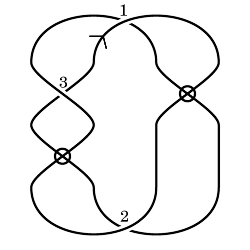
A Gauss code for a virtual knot diagram can be obtained by
numbering all of the non-virtual crossings, then beginning at some
point and travelling along the diagram. At each crossing, indicate
whether you are currently on the over
or on the under
strand, and whether this is a positive or a negative crossing. Virtual
crossings do not show up in the Gauss code. For example, U3+ indicates
the under strand of crossing number 3, which is a positive
crossing.
The gauss code of virtual knot 3.5, shown below, read beginning at the arrow, is O1-O2-O3-U1-U2-U3-.

A Gauss code for the vertical mirror image of a virtual knot diagram can be obtained from the original Gauss code by replacing every O with U and vice-versa, as well as every + with -, and vice-versa. Taking the horizontal mirror image replaces + with - and vice-versa. A Gauss code for an inverse is simply the original Gauss code backwards.